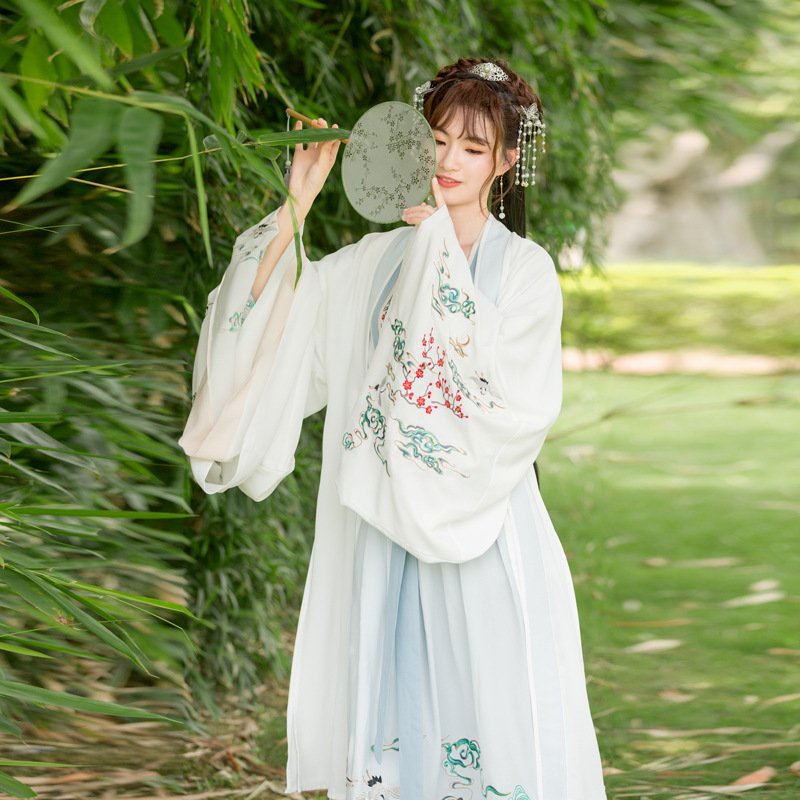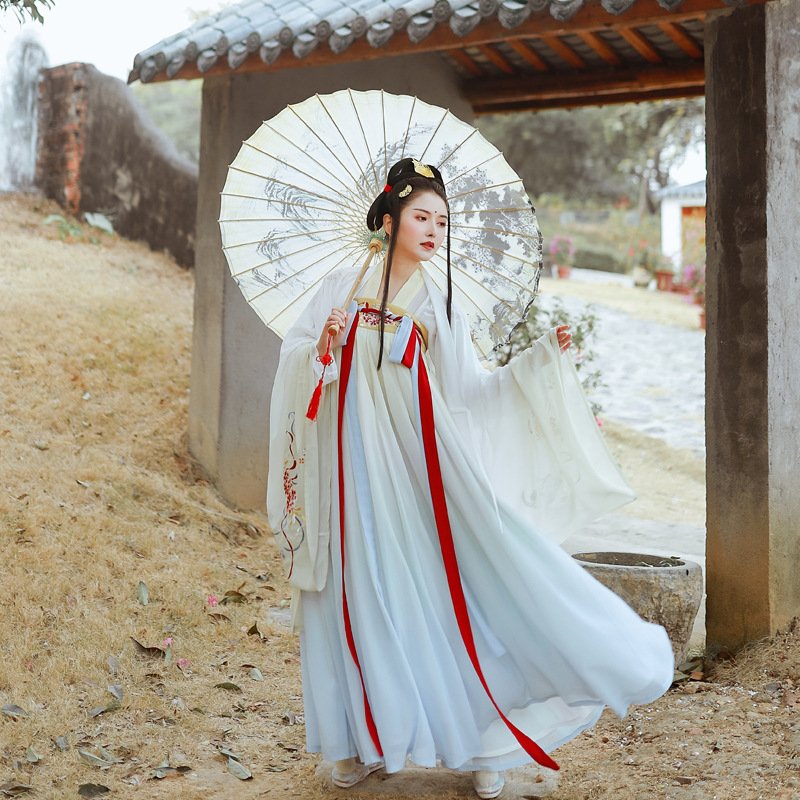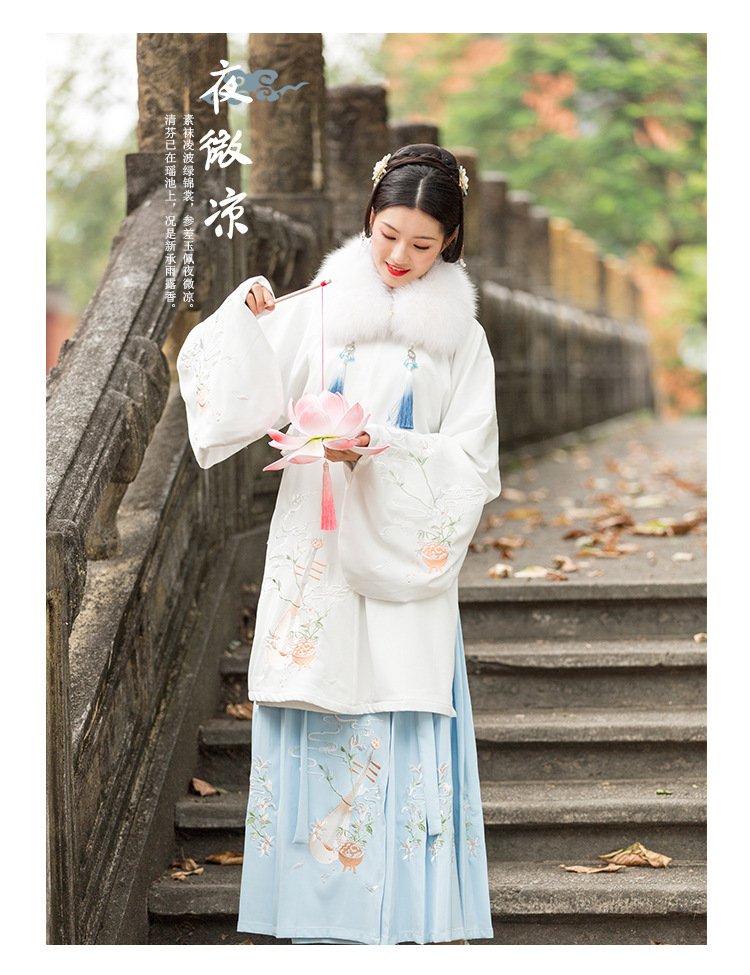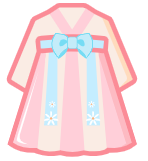In recent years, the streets of Beijing, Xi’an, and even London or New York have occasionally looked like movie sets: young men and women stride past in sweeping silk robes, wide sleeves fluttering, sashes trailing, hair pinned with jade or gold. The garments look “ancient,” yet the wearers hold smartphones and order bubble tea. These clothes are not theatrical costumes; they are hanfu—the living, evolving dress of the Han Chinese, reborn in the 21st century. But what, precisely, is a hanfu dress? The answer is more layered than the garments themselves, entwining three millennia of technology, ritual, gender codes, philosophy, and politics. This essay unpacks the term “hanfu” by tracing its historical construction, its canonical visual grammar, its dynastic mutations, and its modern re-invention as both fashion statement and cultural symbol.
I. Etymology and Basic Definition
The word hanfu (漢服) is simply two Chinese characters: Han (漢) the dominant ethnic group that formed the core of dynastic China, and fu (服) “clothing” or “dress.” Yet the compound is not ancient. It appears rarely in pre-modern texts because, to the Han themselves, their clothing needed no ethnic qualifier—it was clothing. Only after the 17th-century Manchu conquest imposed the queue and the qipao did Han literati begin to speak self-consciously of “Han clothing” as a lost heritage. Today the term operates on three sliding scales:
- Broadest sense: any attire worn by Han people before the Qing dynasty (1644-1912), ranging from neolithic hemp skirts to Ming brocade robes.
- Commonly used sense: the cross-collar, tied-with-sash, loose-robed silhouette that crystallised during the Zhou–Han period and persisted with variations until the 17th century.
- Contemporary fashion sense: modern garments whose cut, iconography, or self-presentation explicitly reference that pre-Qing canon, regardless of fabric or occasion.
II. The Canonical Grammar: How to “Read” a Hanfu
Regardless of dynasty, a hanfu ensemble is built from modular components whose presence or absence instantly signals gender, status, season, and ritual purpose.
- Upper Garment (yi 衣)
- Cross-collar (jiaoling youren): the left lapel wraps over the right; the reverse was reserved for corpses.
- Sleeve taxonomy: narrow for labour (shùhè 裋褐), wide for gentry; extreme “big sleeves” (dàxiùshān) for Tang court dancers.
- Length: hip-length for women’s ru 襦, knee or calf for men’s pao 袍 or shenyi 深衣.

- Lower Garment
- Skirt (chang 裳 or qun 裙): rectangular panels pleated or tied; the horse-face skirt (mǎmiàn qún)—four flat front/back panels with pleated sides—became the Ming standard.
- Trousers (ku 褲): usually hidden; only visible in military or riding dress.
- Sash & Girdle
A woven or silk belt secures the garment; jade plaques (jùe 玦) clack out rank: dragon for Son of Heaven, carp for scholars, gourd for doctors. - Outer Layers & Accessories
- Beizi 褙子: straight-front, open-sided coat, Song-Ming universal layer.
- Pibo 披帛: flying silk shawl, Tang woman’s “scarf that turns every step into dance”.
- Headwear: men’s jīn 巾 cloth caps, women’s ji 笄 hairpins whose length and ornamentation were legally regulated.
Colour and motif form a second language. Zhou ritual texts already codified “green for spring, red for summer, white for autumn, black for winter.” Tang sumptuary law allowed only princesses to wear full-drag phoenix embroidery; Ming merchants caught in dragon robes could be executed.
III. Dynastic Evolution: 1000 BCE to 1600 CE
Zhou (1046–256 BCE): The ritual classics describe the shenyi—“deep robe” cut in one piece to symbolise integrity. Archaeological finds at Jiangling show hemp shenyi with curved hems (qūjū) already 220 cm long, designed to pool on the floor and force a slow, dignified gait.
Han (206 BCE–220 CE): Silk replaces hemp among elites; the ruqun (short blouse + long skirt) becomes the default female silhouette. A 2nd-century CE tomb mural in Henan depicts servants lifting skirts exactly 7 cm off the ground—an early dress-code manual.
Tang (618–907 CE): Cosmopolitanism enlarges everything: sleeves balloon to 90 cm cuffs; the chest-high qíxiōng ruqun hikes skirt ties above the bust, creating the empire waist 1100 years before Paris. Foreign motifs—Central Asian pearl roundels, Sasanian lions—march across silk woven with weft-faced samite techniques.
Song (960–1279 CE): Neo-Confucianism reins in excess. Palette shifts to ink-wash greys; the beizi coat appears, its side slits allowing the wearer to bow without fabric bunching—a sartorial bow to ritual propriety.
Ming (1368–1644 CE): Nationalist revival. The Hongwu emperor orders “return to Tang,” but tailors innovate: the lánshān scholar robe adds a horizontal knee band to echo ancient jūn rank insignia; women’s mǎmiàn qún uses 6–8 metres of cloth, its flat panels perfect for displaying embroidered mǎn hǔ 满襞 pleats that swirl like pinwheels when walking.

IV. The Qing Interruption and Diaspora Memory
1645: the Manchu regent Dorgon issues the “Hair and Garment Edict”—cut queue or lose head; Han robes outlawed in public. Hanfu did not vanish overnight: brides still wore fēngguān xiápèi phoenix crowns underground, and Ming loyalist monks painted self-portraits in zhíduō robes. Yet by 1750 the qipao and chángshān had replaced hanfu in daily life, and the memory of “Han dress” survived mainly in Korean hanbok, Japanese gofuku, and Vietnamese áo giao lĩnh—all exported Tang-Ming cuts preserved abroad.
V. Archaeology, Nationalism, and the 21st-Century Revival
In 2003 a power-plant worker in Zhengzhou, Wang Letian, stitched a Ming-style zhíshēn dàopáo and wore it to the supermarket. Photos went viral; within months online forums coined the slogan “穿我汉家衣裳” (“Wear the clothes of our Han family”). By 2020 the state-run China Daily estimated 5 million “hanfu enthusiasts,” a 1.4-billion-yuan market, and 2,000 rental studios in Xian alone.
Contemporary hanfu spans three subcultures:
- Archaeological Restorationists who embroider with historically accurate 1:4 twill and natural indigo, referencing only excavated relics.
- Fantasy Cosplayers who fuse hanfu with xianxia film aesthetics—iridescent chiffon, LED-lit sashes—sold on Taobao under tags like “fairy sister style.”
- Daily-life Adaptors who shrink sleeves for subway turnstiles, pair ruqun with sneakers, and treat hanfu as slow-fashion alternative to Zara.
International reception oscillates between admiration and Orientalist flattening. At 2019 New York Comic-Con a hanfu flash-mob was applauded as “real-life poetry,” yet Instagram algorithms still tag such posts “kimono.” Korean netizens accuse China of “stealing hanbok heritage,” igniting Twitter wars over shared Tang silhouettes. Meanwhile UNESCO listed “traditional hanfu craftsmanship” on its 2022 intangible heritage register, citing 24 regional weaving and dyeing techniques.

VI. Conclusion: Hanfu as Moving Target
So, what is a hanfu dress? It is at once:
- a material fossil—silk threads whose weave patterns map 3000 years of trade routes;
- a grammar book—collar widths and sleeve curves that speak rank, gender, season;
- a political palimpsest—outlawed in 1645, weaponised in 1911 anti-Manchu cartoons, commodified in 2021 live-stream sales;
- and an unfinished sentence—every teenager who ties a ruqun in 2025 adds a new clause to the story.
To wear hanfu today is therefore not to step into a museum diorama but to enrol in an open-source language: the vocabulary was codified by Zhou ritualists, revised by Tang weavers, censored by Qing edicts, and is now being re-coded by TikTokers stitching 1080p embroidery tutorials at 2 a.m. The dress is never finished; it waits for the next body to animate its sleeves, the next observer to read its pleats.

